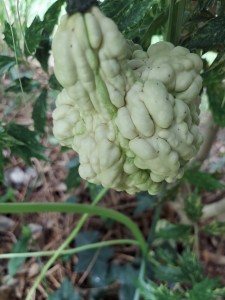 Late last spring I noticed a large leaf sprouting in my front garden. It didn’t quite look like a weed, but it also didn’t look like anything that I had planted intentionally. Curiosity coupled with an inclination to benign neglect led me to leave the plant alone. It rewarded my non-efforts by growing…and growing and growing.
Late last spring I noticed a large leaf sprouting in my front garden. It didn’t quite look like a weed, but it also didn’t look like anything that I had planted intentionally. Curiosity coupled with an inclination to benign neglect led me to leave the plant alone. It rewarded my non-efforts by growing…and growing and growing.
My mystery garden guest was clearly a vine. It made its way gradually across the bed, extending its stems in all four directions. When it got to the medium-size osmanthus shrub, it began clambering upward, clinging to the branches. It did the same thing with the holly that bounds the bed. Shoots began curling out into the grass and I had to turn them back towards the middle of the bed.
As the vine expanded, it sprouted more giant leaves, some of which were eight inches across. Large yellow/orange trumpet-shaped blooms burst forth. It became clear to me that my serendipitous plant was part of the cucurbit or squash family. For awhile I assumed that the large leaves presaged a pumpkin of some kind. I was wrong. Each flower lasted for exactly one day before wilting back. Some of the spent blossoms sported tiny fruits at their bases. I knew that these were the female, fruit-producing flowers and the little fruits were clearly ornamental gourds.
I was intrigued. Years ago I tried to grow ornamental gourds and failed because the local pollinators ignored the flowers and I was too busy to do the job by hand. My mystery gourd flowers were clearly being pollinated, probably because they were growing right next to a large butterfly bush that draws pollinators by the score.
How did the mystery gourd get to my front bed? I suspect it was a case of squirrel landscaping, a process that generally results in a plethora of unwanted chestnut and oak seedlings. Last fall, I decorated my front porch with a basket of ornamental gourds from the garden center. Eventually a squirrel made off with one of them. I suspect that as it ate the gourd, some of the seeds escaped. The ground was fertile enough and the climate congenial enough to induce germination. My gourd vine was born.
When the tiny gourds started to appear, I started research. Ornamental gourds fall into two species: Lagenaria and Cucurbita. Lagenaria gourds are “hard shelled” and generally green, sometimes accented with white. Cucurbita gourds are described as “soft shelled”, though the skins are quite firm.
If you have seen the large green and white “swan” gourds, you have seen one of the hard-shelled types. My gourds, which are rounded and warty, featuring either short or elongated handles or necks, are soft-shelled types. These come in a wide variety of shapes, sizes and colors, including shades of green, white, cream, yellow and golden/orange. Both hard and soft-shelled varieties can be dried for use in crafts and decorations.
As my gourds began to mature, they took on colors. One, nestled close to the ground, is green and white striped. Another, hanging from the holly tree, features green and pale yellow stripes, with a handle or neck that is about twice the height of the rounded base. Its appearance made me wonder whether hanging results in gourds with longer handles.
I discovered that optimal planting situations for ornamental gourds include sunny locales. Intentional gourd-growers plant one or two seeds in a six-inch tall hill of soil, keeping at least four feet between hills. Those who grow a lot of gourds also separate the rows by six feet and train the young vines up trellises or other man-made supports.
I did none of those things. The squirrel, intent on stuffing itself, picked the location and clearly knew nothing about hilling up the plantings. Mother Nature provided the supports.
The vine continues to extend outward and form new flowers each day. Every couple of days I discover a new young gourd. Now that the stems have dried out on the oldest fruits, I have harvested several of them. It looks as though there will be many more in the next few weeks.
It is too late to plant ornamental gourds this year, as they take about 120 days to grow from seed to mature gourds. In the spring you can purchase packets of either mixed or single varieties and start them inside or outside after all danger of frost has passed. If you don’t want to do that, I suggest arranging a lovely basket of gourds on your porch. Wait for one of the million neighborhood squirrels to steal a gourd and hope that the squirrel’s autumnal meal will provide you with a late summer serendipity vine like mine.
